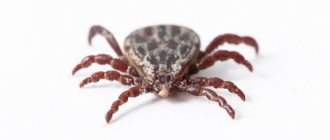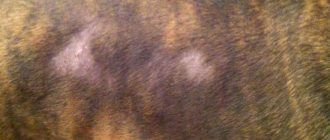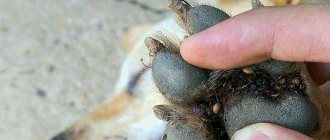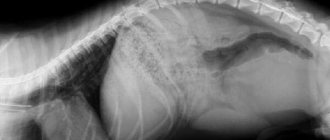The most common carriers of dangerous diseases in dogs are ixodid ticks. Canine and taiga animals carry borreliosis, babesiosis (pyroplasmosis), bartonellosis and others. There are carriers of plague, tularemia, brucellosis, Q fever and listeriosis and other diseases.
If a dog is bitten by a tick, the symptoms and consequences are not immediately apparent. The incubation period for tick-borne diseases ranges from a week to two months.
If a tick is found on a dog, the most important thing is not to panic, remove it correctly, carefully observe how the pet behaves, and if there is any suspicious change in behavior or condition, seek veterinary help. You should know that on average from 3 to 14% of the entire ixodid population are contagious.
Any modern antiparasitic medicine is extremely toxic; it kills not only the parasite, but also affects the dog’s internal organs: kidneys, liver, gastrointestinal tract (GIT), and also reduces immunity. Especially if several techniques are required. In this connection, subsequent long-term rehabilitation is necessary, which cannot be neglected. For at least 10 days it is necessary to give injections of vitamins, saline solutions, drugs to improve heart function, normalize the functioning of the liver, gall bladder, and gastrointestinal tract. At the slightest deterioration of the condition, you need to do a repeat blood test for the causative agent of the disease.
First aid for a dog after a tick bite
Owners should inspect their pet's head, neck, chest, ears and groin after each walk to detect bloodsuckers. If single individuals are found, they must be urgently removed and burned. To avoid contracting diseases dangerous to humans, do this with protective gloves. Do not crush the tick or get it into the oral cavity or mucous membranes. For multiple bites, contact your veterinarian.
If medical help is far away, give your dog 100-150 ml of water every hour. If vomiting, give an enema or subcutaneous injection. You can subcutaneously inject 20 ml of glucose solution and vitamins B6 and B12 in an ampoule daily three times a day. In case of clearly defined symptoms and lack of help, an injection of a 7% solution of Veriben or Azidine is given at the rate of 1 ml per 20 kg of dog weight.
How to take a blood test from a dog yourself: treat the ear with alcohol, cut the vessel close to the edge, collect the blood on a glass plate, dry it a little and take it to the clinic.
Prevention recommendations
Infection cannot be ruled out, but the risk can always be reduced. Important for your pet's health
:
- Don't neglect vaccination. Passive immunity lasts for six months. Even if infected, a vaccinated individual will tolerate the disease more easily.
- Limit communication with unfamiliar four-legged animals. Most often, stray dogs and wild animals become carriers. And playing with a fluffy squirrel is fraught not only with invasion, but also with rabies.
- Carefully inspect hard-to-reach places on your body after each walk. The speed at which the first symptoms appear varies from person to person. If no signs are found, then repeat the skin examination after a couple of hours.
- Control your diet. A proper and balanced diet is the key to a strong immune system.
- Contact a veterinary clinic for help with any questions or suspicions. It is better to make mistakes several times than to lose your beloved dog due to carelessness.
- Use anti-tick agents during periods of increased parasite activity: from April to October. If the dog has long hair or profuse sweating, which requires frequent washing, increase the recommended dosage of medications.
- Avoid mating if infestations are detected. Feel free to ask for information from the second owner.
- Sterilize after infection with subcutaneous parasites. Not only future offspring can suffer, but also the bitch herself. Relapse of the disease occurs against the background of any hormonal changes.
Antiparasitic agents include vaccines, collars, sprays and drops. Each of them has its own advantages and disadvantages.
Vaccine
Giving your pet a vaccine will reduce the likelihood of infection. The most popular include “Nobivak Pro” and “Pirodog”. These vaccines protect against piroplasmosis. Only healthy animals are allowed to be vaccinated. Vaccination after infection is pointless.
To consolidate the result, a second vaccination is given 1 month after the first vaccination. All subsequent ones are done once every six months independently or in a veterinary clinic.
Collars
Collars last for more than six months, but often cause local allergic reactions. If your pet's hair falls out, you will have to abandon the collar in favor of drops or sprays.
“ Due to the ingredients included, the collars are not suitable for nursing or pregnant women, puppies under 2 months of age, or animals with chronic illnesses.
The smell emitted by the product repels insects and remains on the body for some time even after removal. According to the method of exposure, they are chemical, biological and ultrasonic. The first two are repelled by the smell of chemicals or essential oils, and the last one is repelled by ultrasound, which is detected only by arachnids. An ultrasonic collar is more expensive than its analogues, but is considered safer.
How to properly remove a tick from a dog?
Remove the tick with tweezers, trying to grab its body close to the skin. You need to pull the parasite slowly, holding the animal's skin with your free hand. Scrolling may cause the head of the parasite to come off, so be careful. Pet stores sell special tweezers for removing ticks.
Then you should generously treat the wound with iodine. Now all that remains is to monitor the dog daily for the next 2-3 months, and also measure the temperature. If clinical symptoms appear: lethargy, decreased activity, poor appetite, diarrhea, changes in the concentration, color and smell of urine and others mentioned above, immediately contact your veterinarian.
Is it necessary to contact a veterinarian?
Only a trained specialist will be able to properly remove a tick and reduce the risk of your dog getting sick to a minimum.
A visit to a specialist will save your pet’s life
In addition, if a dog is bitten by a tick, but there are no symptoms, this does not mean that the dog is healthy. Many diseases occur latently or appear when it is no longer useful to treat the animal. Often the signs of different diseases are similar, and only in a veterinary clinic will they take tests and make the correct diagnosis.
Therefore, if a tick is found on a dog, it is necessary to take it to the veterinarian as soon as possible.
What diseases can ticks transmit to dogs?
Hepatozoonosis
. Caused by protozoa of the genus Hepatozoon, which infect leukocytes, spreading throughout the animal's body. This is usually due to ingestion of a parasite. Often the disease does not make itself felt for several years while the immune system is normal. When immunity decreases, fever, joint and muscle pain, weakness, and eye discharge begin. Not dangerous for people.
Ehrlichiosis
. They provoke rickettsiae - Ehrlichia. Settles in white blood cells: platelets, monocytes and granulocytes. There are rickettsiae that are dangerous to people. The disease came to Russia from Europe and the USA. A sign of all ehrlichiosis is an exhausting, growing fever.
Monocytic ehrlichiosis
: weight decreases, the animal urinates blood, the number of platelets and leukocytes decreases, weakness, hemorrhages on the cornea, mucous membranes, skin, nosebleeds, anemia, heavy breathing are observed.
Granulocytic ehrlichiosis
: high fever, weakness, cramps, inflammation of the eyelids, joint pain, enlarged liver and spleen, protein in the urine, low albumin and platelets. After 2-3 weeks, the animal’s activity decreases and lethargy appears. Sometimes it develops in a latent form and leads to severe damage to the eyes, bone marrow, joints, liver and other organs.
Bartonellosis
– red blood cells, macrophages and endothelial cells infect bacteria of the genus Bartonella.
Some Bartonella are also dangerous for people. Symptoms
: from prolonged carriage to sudden death without pronounced signs. Clinic: high fever, inflammation of the joints, drowsiness, weight loss, weakness of the hind legs, anemia, disturbances in the functioning of the heart and blood vessels, inflammation of the eyelids, nosebleeds, hemorrhages in the eyes, inflammation of the subcutaneous vessels, meningitis, pulmonary edema.
Borreliosis
(Lyme disease) is a dangerous disease for dogs and people caused by bacteria of the genus Borrelia. It is transmitted in utero and often leads to the death or non-viability of the cubs. Causes arthritis and neurological disorders. First, the joints near the bite site become inflamed. Sometimes lameness goes away on its own. Hosts become infected with borreliosis by crushing a tick. The consequences of the disease are neurological disorders, chronic inflammation of joints, blood vessels, internal organs, etc.
Babesiosis
(
pyroplasmosis
) is the most common disease for dogs.
Not dangerous for people. Caused by different types of Babesia. Symptoms
: lethargy after a bite, jaundice, fever, shortness of breath, gastrointestinal disorders, disorders in the liver, heart, lungs, kidneys and other organs. Dark: Brownish or red urine indicates kidney failure. The animal refuses food and drinks a lot of water.
Symptoms and consequences of a tick bite in a dog
What symptoms will appear if a dog is bitten by a tick? Often the animal becomes worried because of this: it itches, shakes its head if the tick has got into the ear. What does the bite site look like? Most often, at the site of the bite, two to three hours after the parasite is removed, pronounced local redness is observed, which gradually goes away on its own. The basis of skin reaction is allergy. The severity of the symptoms depends on the type of tick, the duration of its attachment, weather conditions over the past two weeks and the state of the animal’s immunity.
The photo shows a tick bite mark on a dog.
Clinical signs are swelling, increasing radially from the center, increased skin temperature in this area, redness, itching and pain. The animal licks and scratches the bite sites. In some cases, granulomatous dermatitis begins on the second day after removing the tick.
If a lump appears at the site of the bite, this may be the result of an allergy to the parasite's saliva or infection of the wound. Hair may fall out at the site of the bump, and the dog reacts painfully to touching it.
Purulent inflammation at the site of the bite appears due to the introduction of pyogenic microbes into the open wound. Thorough antibacterial treatment and, if necessary, administration of antihistamines are required. Another reason for the bump is the head of the tick remaining in the wound. This is very dangerous - the remains of the tick begin to decompose and cause blood poisoning. See a doctor immediately - minor local surgery will be required.
Maria Smirnova
Veterinarian in a private clinic, work experience – 8 years.
It is most likely that the symptoms of the disease will appear 6-10 days after the tick attack, but it matters how the disease progresses. If the disease develops at lightning speed, you may simply not have time to take action. Fortunately, such developments do not occur often.
Pay attention to the rapid rise in body temperature to 41-42°C. This is the dog’s body’s response to the introduction of the parasite, and after a couple of days the temperature will normalize, and later it will decrease. After removing the tick, measure the temperature in the animal's anus daily. Normal temperature in dogs is 38.5°C.
Usually, the difficulty of making a diagnosis is that the symptoms of a tick bite can be different. But almost all animals refuse to eat, show drowsiness and apathy. Some of the following symptoms may appear: trembling, thirst, shortness of breath, pale mucous membranes, abdominal pain, foul odor from the mouth, blood in the urine, vaginal bleeding (in bitches), impaired motor reflexes: unsteadiness of gait, paralysis of the hind limbs (“tick paralysis”) "), dysphonia (the dog cannot bark), dysphagia (lack of swallowing), sometimes vomiting and diarrhea and some others, which we will discuss below. Signs of the disease usually increase in severity.
What to do
To save a dog after a bite, you need to provide first aid, remove the tick, place it in a bottle and take it to the clinic. There they will conduct a study to detect the DNA of pathogens and prescribe treatment.
If the tick turns out to be free of contagion, observe the dog and remember that pathological symptoms may appear several months after the bite.
First aid for a bite at home
If you find a tick, it must be safely removed.
Don’t panic, even if the arthropod is infected, it takes a day or more for the pathogens to reach the salivary glands of the parasite.
However, one cannot be careless. There may be microorganisms inside the tick that can cause human illness. When crushed, protozoa or bacteria can enter the bloodstream through mucous membranes or skin pores. Therefore, wear gloves.
The opinion that a tick can be killed by lubricating the spiracles with oil is unfounded. The arthropod can live without oxygen for more than a day. During this time, pathogens will enter the bloodstream. Applying an insecticide to the parasite does not always help. The tick will not die soon, but the dog will have time to become infected.
Do not remove an attached parasite with tweezers.
If limbs or the head remain in the wound after a bite, inflammation will develop.
Use professional tick removers.
I tried to pull out the tick with Anti-Tick tweezers. I did not like. The inflated parasite burst, blood sprayed out, it’s good that he dodged and didn’t get a jet in his eyes.
Anti-mite
Perhaps this is my subjective opinion. But Tik Twister delighted me. I turned the tick out the first time.
Tick Twister
The device resembles a nail puller and costs about 160 rubles. Watch the video and rate.
Recommended reading:
How to remove a tick from a dog?
If you removed the parasite carelessly, after the tick bite a lump may form that is dense and painless to the touch.
Most often, the tumor does not cause harm and is an allergic response to the secretions left by the arthropod. Perhaps the affected area was itchy and the pet scratched it. But the red spot spoils the appearance and can remain at the site of the bite for up to six months.
In any case, observe your pet for 15-20 days. If the dog's behavior has not changed, the mucous membranes have not turned pale or yellowed, it eats well, is active and cheerful, everything is fine.
If a tick leg remains in the wound , the formation will gradually resolve. But when the head remains, there is a high probability of suppuration and the formation of an abscess. Do not fix the defect yourself. You may cause skin irritation that may result in eczema or another type of dermatitis that is difficult to treat. Visit a veterinary hospital and take the medicine prescribed by your doctor.
When you find a dead tick on your dog , pay attention to its size. If it has sucked blood, then take the parasite to a hospital for examination to determine what contagions are inside it. If the arthropod is small, test anyway. You may have used acaricides that killed the parasite. Or the dog snapped his teeth and crushed the arthropod. But there is no guarantee that other ticks will also die. Therefore, it is better to know whether he is infected or not?
I foresee questions about what to do when you are in the forest, at the dacha, there are no veterinary clinics around, and a tick has bitten your dog? Responsible dog breeders, before going into nature, go to a hospital so that the pet can be given an antiprotozoal drug, for example, Piro-Stop, for preventive purposes.
The veterinary industry produces antiprotozoal drugs that are used to kill Babesia after a tick bite based on imidocarb or diminazene aceturate.
Imidocarb derivatives - Piro-Stop, Forticarb, Babezan are produced in solution, are relatively harmless and high in cost (a 10 ml bottle of Piro-Stop - 524 rubles). After opening the container, the medicine must be developed within 28 days.
Medicines based on diminazene aceturate - Azidine, Berenil, Veriben, Pirosan - are produced in powders that are dissolved before use. The drugs are effective and inexpensive (2.4 g of Azidine sells for 30 rubles), but have side effects.
If you risk using the drugs yourself, there is a high probability that you will save the dog, but make it disabled. On the Internet you will definitely run into advice from amateurs like yourself. Therefore, contact your veterinarian by phone and follow his instructions.
Signs and symptoms of piroplasmosis
The single-celled protozoan piroplasma (Piroplasma canis) destroys red blood cells. A blood test shows a sharp decrease in the number of red blood cells. Toxic breakdown products of hemoglobin accumulate in the body, which disrupts the functioning of internal organs. How many days does a dog get sick after being bitten? The answer to this question depends on the initial condition of the animal, but usually the incubation period is 4 – 15 days. Its duration depends on the number of parasites in the blood, the time of blood sucking and the immunity of the victim. If detected early, piroplasmosis responds well to treatment, but long-term rehabilitation is required.
The dog's condition may deteriorate sharply. With an extremely rapid course, the animal dies without obvious signs of disease.
In the acute form, the following symptoms appear: changes in behavior, weakness, lethargy, loss of interest in what is happening, fever up to 42°C, refusal to walk, darkening of urine, pale or yellow mucous membranes, shortness of breath, paralysis of the limbs occurs. Death on 3–7 days from the moment of infection. With timely treatment, the dog's chances of survival are quite high.
With chronic piroplasmosis, all symptoms are blurred, only fatigue and weakness are expressed. In the latent form, symptoms do not appear.
Diagnosis of the disease
Any serious treatment is prescribed after tests and diagnosis. The pet's blood is carefully examined by specialists under a microscope. This allows you to determine the presence of piroplasms. Complex treatment includes not only the extraction and destruction of the pathogen, but also the cessation of intoxication and cleansing of the body. Treatment is prescribed by a veterinarian. Some folk methods of self-treatment are unacceptable. It's unlikely they'll help. In this case, you will lose valuable time.
Even if you are completely sure that your pet was bitten by an infected tick, only a specialist can prescribe treatment. You can find veterinarians who immediately prescribe dangerous antiparasitic drugs without receiving answers from the laboratory. You, as the owner of the animal, must insist that treatment is prescribed only after receiving test results. Today, analysis is carried out literally within a few minutes.
You need to know that all drugs intended to combat parasites have increased toxicity. They can cause significant harm to the body. The stomach, kidneys, liver and other internal organs are seriously affected. After the treatment prescribed by the veterinarian, long-term rehabilitation is prescribed.
( Video : “What to do if your dog is bitten by a tick”)
Main difficulties in diagnosis:
- If you personally removed a tick, after which your dog developed symptoms, then everything is clear. But there are situations when warning symptoms appear out of nowhere. You need to know that after being bitten by an infected tick, the consequences may not appear immediately. Symptoms may occur over time, for example, when the immune system is weakened. For example, if the condition worsens in winter, the owner is unlikely to remember that the dog was bitten by ticks in the summer.
- Quite often, the behavior of infected ticks differs slightly from healthy parasites. Often an infected tick does not attach itself. After a bite it disappears. In this case, the moment of the bite cannot be noticed. If your pet’s health worsens, it is recommended to immediately show it to a veterinarian, even if after a thorough examination the tick was not found on the pet’s body.
How to remove ticks:
- Drip vegetable oil onto the attached parasite. It will block the breathing hole located at the back. This will force the tick to crawl out from under the skin on its own;
- If you don’t have oil on hand, you can use kerosene or alcohol;
- Make a knot in the thread, place it over the tick, as close to the skin as possible, and tighten the knot. Using a thread, unscrew the parasite;
- You can unscrew the attached tick using tweezers. At the same time, control the pressing force. You need to grab the tick firmly enough, but you need to try not to crush it;
- Today in pharmacies you can find a special device for removing ticks. It is presented in the form of a stick, with a curved and forked end. With this device it is enough to simply grab and unscrew the parasite.
How is piroplasmosis treated in dogs?
The sooner treatment for piroplasmosis begins, the higher the animal’s chance of survival. Recovery will last 4–5 weeks at best.
For proper treatment, it is important to exclude similar ailments: liver damage, poisoning, leptospirosis, glomerulonephritis, plague.
It is urgent to do blood and urine tests. A blood test will help quickly identify babesiosis by the many destroyed red blood cells and piroplasms in them. Hemoglobin in the urine of a sick dog confirms the diagnosis.
Stage-by-stage treatment:
- Antiparasitic drugs: Veriben, Berenil, Azidine (diminazine) - less toxic. Stronger: Imidocarb, Imizol, Piro-stop.
- Alkalization of urine for normal kidney function. Sodium bicarbonate is injected intravenously to prevent blockage of the renal tubules by hemoglobin crystals. The animal is also given a solution - 2 g of soda per 10 kg of body weight until the hemoglobin is completely removed from the urine. Instead of soda, you can give the drug blemaren - 1 tablet per 10 kg of weight per day.
- Vitamins, diuretics, glucose, tonic, hemostatic.
- Purification of blood by transfusion or filtering.
- A recovered dog should be limited in movement for 10-15 days. Special care and diet will be required.
After the disease, unstable immunity lasts 4-6 months. Afterwards, there is a risk of becoming infected with piroplasmosis again.
Symptoms of encephalitis in dogs
Of course, encephalitis is primarily dangerous for humans, but if the immune system is weakened, the dog can also get sick. The bite of an encephalitis tick causes severe symptoms. The incubation period is about 2-3 weeks. Typically, there is an increase in temperature, convulsions, impaired motor functions, and paralysis. A characteristic symptom is hypersensitivity of the head and neck, severe pain. A change in mood may occur - apathy or aggression, and later - paralysis of the facial and eye muscles. There is obvious brain damage, and since there is no specific treatment for encephalitis for dogs, the prognosis is unfavorable: almost one hundred percent death. Symptoms may go away after the first deterioration, but this is not a cure, but a sign of a suppressed immune response. The encephalitis tick has no special signs.
Can a person become infected?
Not only four-legged animals, but also humans can become infected from an arachnid. The list of the most dangerous diseases includes encephalitis and Lyme disease (borreliosis). They cause irreversible neurological changes that can only be treated in the early stages.
“
It should be noted that the diseases mentioned are dangerous for people, but they are not transmitted from dogs to humans. The risk only arises when an infected tick brought by a dog bites a person. Therefore, anti-tick treatment of your pet should be carried out in completely covered clothing.
Rare types of encephalitis can be transmitted through saliva and other secretions of an animal. But usually tick-borne encephalitis is contracted only from a parasite bite. Borreliosis is not transmitted at all from animals to humans.
A less dangerous disease, ehrlichiosis, can also occur in humans and dogs when bitten by a tick, but they cannot become infected from each other.
But the scabies mite easily travels through the air between all mammals. Therefore, it is recommended to isolate a dog infected with a subcutaneous tick from other residents, and treatment measures should be carried out wearing gloves and special clothing.











